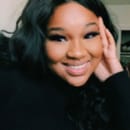After watching Hulu’s Bad Hair over the past weekend— a horror satire film set in the 1980s about a young black womxn who gets her first sew-in in order to advance her career— I also began to reflect on the 2009 documentary Good Hair which similarly explores the cultural significance of hair within the Black community and then thought about my own relationship with my hair. After all, hair, in general, is a big deal for all womxn for different reasons like public perception, self-expression, and even measures of intellect according to this article.
Hair is a complex thing because the way we feel about the locks that grow out of our heads can be personal and private. Yet for those of us who may not wear cultural or religious head coverings, hair is simultaneously a very publicized feature. And like most other aspects of a womxn’s identity, she’ll be judged based on the color, length, and texture. That last point is especially true for black womxn who daily have to face struggles on the basis of race and gender in ways that other groups do not. In this article, I want to open up about my thoughts on Black womxn’s hair in relation to my own, the natural hair movement, and the daily microaggressions we face.

*Here are some of my favorite natural hair gurus you can check out if you want to be both educated and entertained: Chizi Duru, Keke J, BlakeJael, Halfrican Beaute, ChaeButta, FaceOverMatter, GEM Naturals, Janae Mason, Naptural85, Tajah Symone, and Taylor Anise*

Essentially, the internet ruined the natural hair movement. Time and time again, society shows that the voice, concerns, and struggles of Black womxn are unimportant and that it is our job to be inclusive—can you believe that? We’re responsible for our own oppression! The NHM was created for womxn with 4C hair because we don’t have a safe space to be ourselves and relate to people who have the same exact experiences. It’s just frustrating that not only are we excluded from many ‘feminist’ and social justice movements, but when we do create our own as a result of this exclusion, it gets infiltrated by the very people who excluded us.

My journey to self-love and acceptance is not unique; like most Black womxn and girls, I had a time in my life where I hated how I look because society imposes that naturally Black features are ugly (i.e. broader noses, fuller lips, wider hips, and kinky hair). Funny how now everyone wants to look like–nevermind, I digress. But anyway, how I learned to learn myself isn’t important, it was quite simple; I had to take away the things I used to assimilate in order to embrace what I was naturally given. So I stopped contouring my nose, finally started wearing the proper shade of foundation/concealer, stopped concealing my upper lip so it would appear smaller, stopped using perm relaxers—there’s nothing wrong with relaxers or contouring by the way. It’s up to each individual and people can do/wear what makes them feel good. It’s just not my choice anymore because the implications of those choices didn’t align with my journey and that’s what matters at the end of the day—and anything else that would otherwise be a form of self-hating behavior in order to become the “desirable” and palatable version of Blackness.
It’s my hope that you’ve learned something from this and that you can understand that while hair is important to our identity, it is not our identity.


